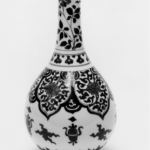Originating from Jingdezhen City in China, often referred to as the porcelain capital of the world, artisans perfected the skills to create the most detailed and beautiful works of ceramics. First traces of these porcelain pots date to the Yuan dynasty (1127 – 1279) and evolved in detail and sophistication throughout the centuries (2). It was not until the Ming (1368-1644) and Qing (1644-1911) dynasties that the ceramics became highly pervasive internationally, drawing in significant income because of their unprecedented colors and designs (1). Used daily as dinnerware, these ceramics were also a prominent economic driver serving as an influences for English art (6).
During the collapse of the Ming Dynasty, when the production of blue pots was prevalent, vast quantities of the handcrafted ceramics were destroyed (1). Entering the Qing Dynasty, Emperor Kangxi (1661-1722) was cognizant of the cultural significance and economic importance the ceramics possessed. With this knowledge in mind, The Imperial Porcelain factories were rebuilt and production steadily resumed in 1683 (1). Not only did production resume, but the technique used by artisans was perfected. Glazes were incorporated on the exterior of the ceramics that gave them a brilliant sparkle resistant to debris or water saturation (2). This simple amendment increased the economic potential of the blue-and-white vases and became a widespread characteristic, not only of future ceramic products, but also of the culture of China.
Early in the Yuan dynasty, ceramics made their way into the Chinese culture with the introduction of the cobalt-blue color (2). Remaining a prominent characteristic hundreds of years later, the designs of pots and vases became quite intricate and incorporated designs common to the Chinese heritage, in addition to influences brought upon by other nations. It was not unseen for artisans to favor a particular design in order please potential customers.
After the mid-1700s, despite Europe’s proficiency in the production of ceramics, no work of art could transcend the delicacy, involved design, and quality the Chinese artisans provided (4). The wave pattern that appears as a broad band circulating the vase indicates the influence the Europeans had on Chinese ceramics (4). During the Ming Dynasty, Europeans were the primary consumers of Chinese ceramics influencing the prevalence of the maritime motifs.
Despite this European influence, certain characteristics of this bottle-shaped vase derive from traditional Chinese art design. On the upper region of the vase, we see an intricate orchid flower design slowly maneuver its way towards the brim of the vase. Covering the entire circumference of the neck, these beautiful orchid flowers symbolize perfection, abundance, and higher growth of the Chinese culture (3). For years, Chinese artisans created sophisticated ceramics of distinct shapes and sizes. While the vase is clearly indicative of the detail and care the Chinese had for their unique culture, the stunted shape given to the vase hints at slightly different meanings and foreshadows greater significance. It was not uncommon for large-scale pots to be used for ritualistic and religious purposes (5). However, this petite work of art deviates significantly from historical norms.
Scaling only eight inches in height and just shy of five inches wide, its size suggests it was not used for religious purposes, possibly not even for economic benefit. Rather, its diminutive size hints at the passion and ardor the artisan put forth in creating this work of art. The fine line depicting the stem of the orchid functions as a symbol representing China’s resilience from the hindrance that kept them from producing ceramics after the Ming dynasty. The vibrant cobalt-blue color used throughout the entirety of the porcelain draws back to the rich history and culture that the Chinese value significantly. Drawing back to Chinese values and their rich culture, cobalt-blue is used in the entirety of porcelain. Additionally, the onion-style-design on the body of the vase represents a prevailing and modern design that connects the dated use of the cobalt blue with the alluring modern style (5).
Cultural themes, like colors and designs, were segues for Chinese artisans to produce porcelain products to not only propagate their culture, but sustain them economically. The vivid blue and white colors used in Chinese ceramics help to ensure that the history and culture of China endures throughout the centuries. From the Yuan dynasty to the Qing dynasty, numerous aspects of the production of ceramics dramatically improved (2). Entering the Qing dynasty, artisans delved into a new generation of pottery where standard designs were altered to represent the changing Chinese society. Despite numerous attempts of foreign countries to recreate the delicate blue and white pots from Jingdezhen, Chinese artisans have not only managed to create a work of art incapable of being duplicated, but also a means to spur a prominent aspect of their culture for thousands of years.
MB
1.) Yibo, Yu. “Blue-and-White Porcelain.” Blue and White Porcelain. China Online Museum, 21 Mar. 2009. Web. 16 July 2015.
2.) Chalres Assocication. “Chinese Blue and White Porcelain – The Chalre Collection of Asian Ceramics.” Chinese Blue and White Porcelain. Chlare Association, 2015. Web. 16 July 2015.
3.) Whats-Your-Sign. “Chinese Flowers and Their Symbolism.” Common Chinese Flower Meanings. What Your Sign, 2004. Web. 16 July 2015
4.) Wu, Annie. “Chinese Porcelain History.” ChinaHighlights. China Highlights, 25 Aug. 2014. Web. 16 July 2015.
5.) Nilson, Jan. “Chinese Porcelain Glossary: Blue-and-white.” Chinese Porcelain Glossary: Blue and White. Gotheborg, 2005. Web. 16 July 2015.
6.) Garner, Harry Mason. Oriental Blue and White. London: Faber, 1970. Print.
